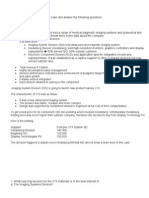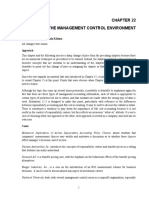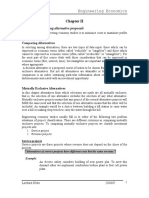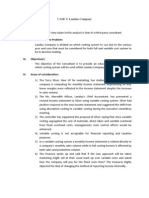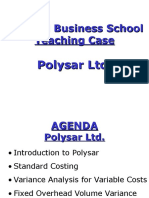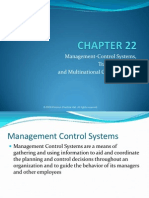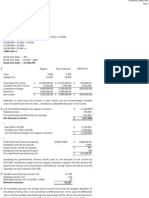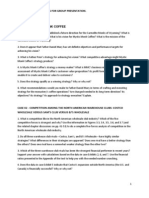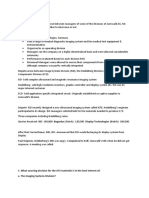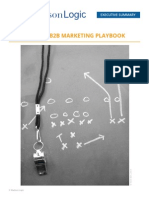Zumwald AG Case Text
Zumwald AG Case Text
Uploaded by
Silvester Dark SlayerCopyright:
Available Formats
Zumwald AG Case Text
Zumwald AG Case Text
Uploaded by
Silvester Dark SlayerCopyright
Available Formats
Share this document
Did you find this document useful?
Is this content inappropriate?
Copyright:
Available Formats
Zumwald AG Case Text
Zumwald AG Case Text
Uploaded by
Silvester Dark SlayerCopyright:
Available Formats
-
--
--
Chapter 7 . Financial Responsibility Centers
In August 2002, a pricing dispute arose between the
managers of some of the divisions of Zumwald AG.
Mr. Rolf Fettinger, the company's managing director,
had to decide whether to intervene in the dispute.
ECD sold application-specific integrated circuits
and subassemblies. ECD was originally established
as a captive supplier to other Zumwald divisions.
but in the last decade its managers had found external markets for some of the division's vroducts.
Because of this, ECD's managers were given profit
center responsibility.
THE COMPANY
Zumwald AG, headquartered in Cologne,
Germany, produced and sold a range of medical
diagnostic imaging systems and biomedical test
was
equipment and instrumentation- The
organized into six operating divisions. Total annual
revenues were slightly more than 3 billion.
Zumwald managers ran the company On a
decentralized basis. The managers of each division
were allowed considerable autonomy if their
performances were at least On plan. Performance
was evaluated, and management bonuses were
assigned, based on each division's achievement
invested
of budgeted targets for retum
(RolC) and
growth. Even
the 'Ompany was partly
integrated,
managers were
to source their
from external suppliers if they so chose.
Involved in the
were
three of the
the Imaging
Systems Division (ISD), the Heidelberg Division
(Heidelberg), and the Electronic Components
Division (ECD).
THE DISPUTE
1, 2001, ISD designed a new ultrasound imaging
system, called the ~ 7 3H~~~~
.
were high for ~ 7 3 .
The new system offered users advantages in processing speed and cost, and it took up less space.
~ ~ i d engineers
~ l b participated
~ ~ ~ in the design
of ~ 7 3 but
,
~ ~ i d ~ was
l b e ~ ~
for
the full cost of the time its employees spent on this
pro,ect.
managers
~f~~~ the specifications were set,
solicited bids for the materials needed to produce
X73 components. Heidelberg was asked to bid to
supply the displays needed for production of the
X73 system. So were two outside companies. One
was Bogardus NV, a Dutch company with a reputation for producing high-quality products. Bogardus
had been a long-time supplier to Zumwald, but
it had never before supplied display units and
systems to any Zumwald division. Display
Technologies PIC was a British company that had
ISD sold complex ultrasound and magnetic reson- recently entered the n~arketand was known to be
ance imaging systems. These systems were expen- pricing its products aggressively in order to buy
market share. The quotes that ISD received were as
sive, typically selling for 500,000-1 million.
Heidelberg sold high-resolution monitors, graphics
controllers, and display subsystems. ApproximCost per X73 system ()
ately half of its sales were made to outside cus~ ~ i d ~ i ,~, i ~ il~ , , b ~ ~ ~
140,000
tomers. ISD was one of Heidelberg's major inside
120,500
Bogardus NV
100,500
customers.
Display Technologies PIC
,
This case was prepared by Professors Kenneth A. Merchant and Wim A. Van der Stede.
Copyright O 2003 by Kenneth A. Merchant and Wim A. Van der Stede.
304
Zumwald AG
After discussing the bids with his management
team, Conrad Bauer, ISD's managing director,
announced that ISD would be buying its display
systems from Display Technologies Plc. Paul
Halperin, Heidelberg's general manager was livid.
He immediately complained to Mr. Bauer, but
when he did not get the desired response, he took
his complaint to Rolf Fettinger, Zumwald's managing director. Mr. Fettinger agreed to look into the
situation.
A meeting was called for August 29, 2002.
Mr. Halperin asked Christian Schonberg, ECD's
GM, to attend this meeting to support his case. If
Heidelberg got this order from ISD, it would buy
all of its electronic components from ECD.
At this meeting, Mr. Bauer immediately showed
his anger:
1. ISD's tentative target price for the X73 system was
340,000.'
2. Heidelberg's standard manufacturing cost (material, labor and overhead) for each display system
was 105,000. When asked, Mr. Halperin estimated that the variable portion of this total cost was
only 50,000. He treated Heidelberg's labor costs
as fixed because Geman laws did not allow him to
lay off employees without incurring expenses that
were "prohibitively" high.
3. Because of the global business slowdown, the
production lines at Heidelberg that would produce
the systems in question were operating at approximately 70% of capacity. In the preceding year,
monthly production had ranged from 60-90% of
total capacity.
4. Heidelberg's costs included 21,600 in electronic
subassemblies to be supplied by ECD. ECD's full
manufacturing costs for the components included
in each system were approximately 18,000, of
which approximately half were out-of-pocket
costs. ECD's standard policy was to price its products internally at full manufacturing cost plus
20%. The mark-up was intended to give ECD an
incentive to supply its product internally. ECD was
currently operating at 90% capacity.
Paul wants to charge his standard mark-up for these
displays. I can't afford to pay it. I'm trying to sell a
new product (X73) in a very competitive market.
How can I show a decent ROIC if I have to pay a price
for a major component that is way above market?
I can't pass on those costs to my customers. Paul
should really want this business. I know things have
been relatively slow for him. But all he does is quote
list prices and then complain when I do what is best
for my division.
Near the end of the meeting, Mr. Bauer reminded
We're wasting our time here. Let's stop fighting
everybody
of the company's policy of freedom of
amongst ourselves and instead spend our time figuring
sourcing.
He
pointed out that this was not such a
out how to survive in these difficult business conditions.
big deal, as the volume of business to be derived
Mr. Fettinger asked Mr. Halperin why he from this new product was only a small fraction
could not match Display Technologies' price. Paul (less than 5%) of the revenues for each of the divireplied as follows:
sions involved, at least for the first few years. And
he
also did not like the potential precedent of his
Conrad is asking-meto shave my price down to below
being
forced to source internally because it could
cost. If we start pricing our jobs this way, it won't be
long before we're out of business. We need to price adversely affect his ability to get thoughtful quotes
our products so that we earn a fair return on our from outside suppliers in the future.
investment. You demand that of us; our plan is put
together on that basis; and I have been pleading with
my sales staff not to offer deals that will kill our mar- THE DECISION
gins. Conrad is forgetting that my engineers helped As he adjourned the meeting, Mr. Fettinger
him design X73, and we provided that help with no promised to consider all the points of view that had
mark-up over our costs. Further, you can easily see been expressed and to provide a speedy judgment.
that Zumwald is better off if we supply the display He wondered if there was a viable compromise or
systems for this new product. The situation here is
clear. If Conrad doesn't want to be a team player, then if, instead, there were some management principles
you must order him to source internally! That deci- involved here that should be considered inviolate.
sion is in the best interest of all of us.
In the ensuing discussion, the following facts
came out:
' The cost of the other components that go into X73 is 72,000.
ISD's conversion cost for the X73 system is 144,000, of which
1 17,700 is fixed.
You might also like
- AJAX OriginalDocument7 pagesAJAX Originalreva_radhakrish1834No ratings yet
- Zumwald Case 1 - Jiya - ChadhaDocument2 pagesZumwald Case 1 - Jiya - Chadhajc1711100% (2)
- ZumwaldDocument7 pagesZumwaldDeddy SeptiadiNo ratings yet
- Typical Cash Flows at The Start: Cost of Machines (200.000, Posses, So On Balance SheetDocument7 pagesTypical Cash Flows at The Start: Cost of Machines (200.000, Posses, So On Balance SheetSylvan EversNo ratings yet
- Case 17-2.lipman Bottle Company Financial and Managerial Accounting (OSexton Herzing U) (Revised.Document11 pagesCase 17-2.lipman Bottle Company Financial and Managerial Accounting (OSexton Herzing U) (Revised.anam khalidNo ratings yet
- Anagene - Final Case AssignmentDocument19 pagesAnagene - Final Case AssignmentSantiago Fernandez Moreno100% (1)
- Ict 2 Finals Exam Besa Bsa2aDocument4 pagesIct 2 Finals Exam Besa Bsa2aJoyce Ann Cortez100% (1)
- This Study Resource Was: ZumwaldDocument2 pagesThis Study Resource Was: ZumwaldVevo PNo ratings yet
- Control: The Management Control Environment: Changes From The Eleventh EditionDocument22 pagesControl: The Management Control Environment: Changes From The Eleventh EditionRobin Shephard Hogue100% (1)
- Report On Sinclair CompanyDocument5 pagesReport On Sinclair CompanyVictor LimNo ratings yet
- Chapter 26Document32 pagesChapter 26karlosgwapo3No ratings yet
- RESULTS ACCOUNTABLITY - Case 3 - Transfer Pricing - ANALYSISDocument8 pagesRESULTS ACCOUNTABLITY - Case 3 - Transfer Pricing - ANALYSISEmma WongNo ratings yet
- Jacobs Suchard Case StudyDocument2 pagesJacobs Suchard Case StudySumit Rajpurohit0% (1)
- Hilton Chapter 13 SolutionsDocument71 pagesHilton Chapter 13 SolutionsSharkManLazersNo ratings yet
- Zumwald AG 3Document23 pagesZumwald AG 3Marian Barradas ConcibidoNo ratings yet
- Chapter 2'Document24 pagesChapter 2'tilayeyideg100% (3)
- Rwanda Creative IndustriesDocument4 pagesRwanda Creative IndustriesJen SobolNo ratings yet
- ZumwaldDocument5 pagesZumwaldAugustnine AdriantoNo ratings yet
- Case Enager IndustriesDocument4 pagesCase Enager IndustriesNikko Sucahyo50% (2)
- Chap 028Document12 pagesChap 028Rand Al-akam100% (1)
- Case - SunAir Boat Builders Part - 2Document3 pagesCase - SunAir Boat Builders Part - 2dhakar_ravi1No ratings yet
- Landau CompanyDocument4 pagesLandau Companyrond_2728No ratings yet
- Dokumen PDFDocument21 pagesDokumen PDFMark AlcazarNo ratings yet
- Case19-4 Landau CompanyDocument1 pageCase19-4 Landau Companysaberrz0% (1)
- Sinclair Company Group Case StudyDocument20 pagesSinclair Company Group Case StudyNida Amri50% (4)
- Catalytic Solutions IncDocument1 pageCatalytic Solutions Incdavid davidsonNo ratings yet
- Delaney Motors Case Study Assignment - Topic 6Document3 pagesDelaney Motors Case Study Assignment - Topic 6Ezra LowNo ratings yet
- Bill French - Write Up1Document10 pagesBill French - Write Up1Nina EllyanaNo ratings yet
- LandauDocument8 pagesLandauJenny Joy SedigoNo ratings yet
- Management Control Systems, Transfer Pricing, and Multinational Considerations 22Document30 pagesManagement Control Systems, Transfer Pricing, and Multinational Considerations 22Martinus WarsitoNo ratings yet
- Balakrishnan MGRL Solutions Ch14Document36 pagesBalakrishnan MGRL Solutions Ch14Aditya Krishna100% (1)
- 3 ManAcc CasesDocument5 pages3 ManAcc CasesalexsophieNo ratings yet
- Birch Paper Company Case Study SolutionsDocument3 pagesBirch Paper Company Case Study Solutionsmina hannaNo ratings yet
- Mba540 MidtermDocument5 pagesMba540 Midtermjs512No ratings yet
- Analysis of PolysarDocument84 pagesAnalysis of PolysarParthMairNo ratings yet
- Operation and Product ManagementDocument2 pagesOperation and Product ManagementIbrahim JawedNo ratings yet
- Finacc PolymediaDocument5 pagesFinacc PolymediaFrancisco MarvinNo ratings yet
- Fajarina Ambarasari - 29118048 - Purity Steel Corporation 2012Document7 pagesFajarina Ambarasari - 29118048 - Purity Steel Corporation 2012fajarina ambarasariNo ratings yet
- Exercise 1 SolnDocument2 pagesExercise 1 Solndarinjohson0% (2)
- Management-Control Systems, Transfer Pricing, and Multinational ConsiderationsDocument30 pagesManagement-Control Systems, Transfer Pricing, and Multinational Considerationsthorat82No ratings yet
- Case StudyDocument11 pagesCase Studyapi-269859076No ratings yet
- Chap 021Document19 pagesChap 021Neetu Rajaraman100% (1)
- Chap 025Document17 pagesChap 025Neetu Rajaraman100% (7)
- Decision MakingDocument8 pagesDecision MakingkhandakeralihossainNo ratings yet
- Additional Questions For Maverick CaseDocument3 pagesAdditional Questions For Maverick Casefranz_karununganNo ratings yet
- Case 17-3, Powerpoint Presentation SHELTER PARTNERSHIPDocument33 pagesCase 17-3, Powerpoint Presentation SHELTER PARTNERSHIPFrancisco MarvinNo ratings yet
- Prestige Telephone Company Case Study Report UneditedDocument13 pagesPrestige Telephone Company Case Study Report UneditedAmor0% (1)
- Hospital SupplyDocument3 pagesHospital SupplyJeanne Madrona100% (1)
- Variable and Absorption CostingDocument3 pagesVariable and Absorption CostingAreeb Baqai100% (1)
- Product Costing in Ten Swedish Manufacturing CompaniesDocument17 pagesProduct Costing in Ten Swedish Manufacturing Companiescohenkris0% (1)
- 17-1 Delaney MotorsDocument2 pages17-1 Delaney MotorsYJ26126100% (6)
- Practice Exam 2020Document11 pagesPractice Exam 2020ana gvenetadzeNo ratings yet
- Question No. 1 5 Marks: Not Including The Costs of Plastic Housing (Column B)Document13 pagesQuestion No. 1 5 Marks: Not Including The Costs of Plastic Housing (Column B)Mawaz Khan MirzaNo ratings yet
- James R Steiner Case 2Document4 pagesJames R Steiner Case 2api-285459465No ratings yet
- Case-Study - Private FitnessDocument4 pagesCase-Study - Private FitnessIndustry ReportNo ratings yet
- Case Questions - EssentialsDocument9 pagesCase Questions - EssentialsHarry KingNo ratings yet
- Balakrishnan MGRL Solutions Ch09Document53 pagesBalakrishnan MGRL Solutions Ch09Rachna Menon100% (1)
- Zumwald CaseDocument4 pagesZumwald CaseGks06No ratings yet
- Case StudyDocument3 pagesCase Studyvinod sambraniNo ratings yet
- Case Summary Aug 2015-Pricing Dispute Arose Between Managers of Some of The Divisions of Zumwald AG. Mr. About Zumwald CompanyDocument2 pagesCase Summary Aug 2015-Pricing Dispute Arose Between Managers of Some of The Divisions of Zumwald AG. Mr. About Zumwald CompanyAbNo ratings yet
- Week 5 - Practice CaseDocument3 pagesWeek 5 - Practice CaseClaudele VezinaNo ratings yet
- Prashant Khorana - ES1 - ZumwaldDocument3 pagesPrashant Khorana - ES1 - ZumwaldPrashant KhoranaNo ratings yet
- EU Regions ProgrammeDocument26 pagesEU Regions ProgrammeN NNo ratings yet
- E0002 Employee Turnover in It SectorDocument75 pagesE0002 Employee Turnover in It SectorwebstdsnrNo ratings yet
- GM0744Document3 pagesGM0744Manuel CHNo ratings yet
- NPV Practice CompleteDocument5 pagesNPV Practice CompleteShakeel AslamNo ratings yet
- Practice Questions Chapter 10Document5 pagesPractice Questions Chapter 10Nguyễn Bảo NgọcNo ratings yet
- The New B2B Marketing Playbook: Executive SummaryDocument11 pagesThe New B2B Marketing Playbook: Executive Summaryaggold616No ratings yet
- Julio Ramos - Resume Dec 2017Document2 pagesJulio Ramos - Resume Dec 2017api-387993621No ratings yet
- Surf ExcelDocument38 pagesSurf Excelangelsaraswat100% (2)
- SIT Artikel 5Document20 pagesSIT Artikel 5Oxky Setiawan WibisonoNo ratings yet
- Case Study - 2: Dell ComputersDocument3 pagesCase Study - 2: Dell ComputersShUbhAm sMaRtYNo ratings yet
- The Impact of Total Risk Management On Company's PerformanceDocument7 pagesThe Impact of Total Risk Management On Company's PerformanceUsama WalyNo ratings yet
- RBI Fair Practice CodeDocument3 pagesRBI Fair Practice Codeanon_574914624No ratings yet
- Profile On High Grade ContractorDocument24 pagesProfile On High Grade ContractorLeulNo ratings yet
- ReceivablesDocument5 pagesReceivablesHanns Lexter PadillaNo ratings yet
- Placement Report Analysis - 2019: BATCH: 2017-19Document5 pagesPlacement Report Analysis - 2019: BATCH: 2017-19DivyanshKhareNo ratings yet
- Entrepreneurship Skills Assignment 1Document10 pagesEntrepreneurship Skills Assignment 1fabiolabeukesNo ratings yet
- I. Nature of Business and Accounting Module (Aao Tutorials 2018)Document6 pagesI. Nature of Business and Accounting Module (Aao Tutorials 2018)by ScribdNo ratings yet
- Planning 2-Module 4Document55 pagesPlanning 2-Module 4Abegail LaronNo ratings yet
- Answer To DAF BURERADocument72 pagesAnswer To DAF BURERAbomujykijaNo ratings yet
- 1 Intro To MarketingDocument8 pages1 Intro To MarketingGodwin Jil CabotajeNo ratings yet
- Study Material CH.-1 Fundamentals of Partnership 2023-24Document28 pagesStudy Material CH.-1 Fundamentals of Partnership 2023-24vsy9926No ratings yet
- Topic 5 Part 2Document22 pagesTopic 5 Part 2ericlimkj83No ratings yet
- Invitation: Integrated Food and Nutrition Security Initiative Presidential MeetingDocument3 pagesInvitation: Integrated Food and Nutrition Security Initiative Presidential MeetingCityPressNo ratings yet
- Profit Maximization and Wealth MaximizationDocument16 pagesProfit Maximization and Wealth MaximizationOnindya MitraNo ratings yet
- Milestone 1 - Acc 640Document6 pagesMilestone 1 - Acc 640Floyd SeremNo ratings yet
- Industrial RelationsDocument4 pagesIndustrial RelationsRahul RanjanNo ratings yet
- Module 1 - Basics of Mutual FundDocument13 pagesModule 1 - Basics of Mutual FundGAZA MARY ANGELINENo ratings yet


